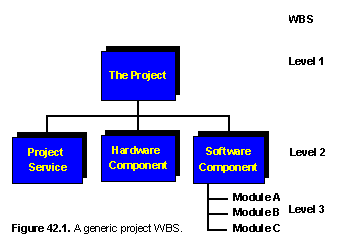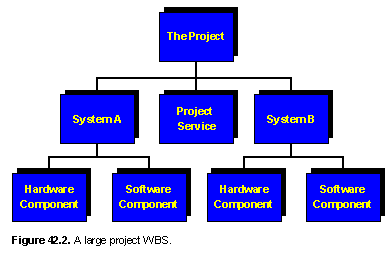Concept: Work Breakdown Structure
- Introduction
- Definition
- WBS Role
- WBS
Structure
- Large
Project WBS
- Frequently
Asked Questions
|
A key strategy of effective planning is to partition
the project into manageable chunks that can be
individually planned estimated and controlled. The work
breakdown structure is a graphical tool that displays the
project's statement of work making it easier to
understand and communicate. It is employed from the
earliest stages of project planning.
|
 The work breakdown structure (WBS) is a powerful tool
for expressing the scope or extent of a project in simple graphic
terms. It represents the project in terms of the hierarchy of
deliverables and services it will produce. The project is
therefore described just as a manufacturer would document the
bill of materials breakdown for a washing machine or automobile.
The WBS starts with a single box at the top which represents the
whole project. The project is then partitioned into its
components with lower level boxes.
The work breakdown structure (WBS) is a powerful tool
for expressing the scope or extent of a project in simple graphic
terms. It represents the project in terms of the hierarchy of
deliverables and services it will produce. The project is
therefore described just as a manufacturer would document the
bill of materials breakdown for a washing machine or automobile.
The WBS starts with a single box at the top which represents the
whole project. The project is then partitioned into its
components with lower level boxes.
The WBS supports the principle of management by
deliverables providing a map of what is
to be produced.
The role of the WBS is to:
- Partition the major project deliverables
into smaller components to improve the accuracy of cost
estimates
- Provide a mechanism for collecting and
organizing actual costs
- Provide a mechanism for performance
measurement and control
Note that the WBS provides a simple map of what
is to be produced. It does not deal with schedules and therefore
has no time dimension. It is however used as entry criteria for
schedule development.
 Figure 42.1 describes a typical high level WBS structure
for a small to medium sized project. The box at the top (The
Project) represents the total system and is referred to as WBS
level 1. Lower levels which describe project components in
increasing detail are numbered 2, 3, 4 and so on.
Figure 42.1 describes a typical high level WBS structure
for a small to medium sized project. The box at the top (The
Project) represents the total system and is referred to as WBS
level 1. Lower levels which describe project components in
increasing detail are numbered 2, 3, 4 and so on.
The concept of WBS level is important as it
allows you to designate the level of detail at which you report
cost estimates and project cost performance figures. For example,
to effectively manage a large project a senior manager typically
needs summary details of cost variance at level 2. By contrast
the team leader responsible for developing a level 2 software
component needs cost performance reports at level 3.
The partitioning of the project into major
components occurs at level 2. Components at this level fall into
the following classes:
Project Service. Project services that
apply to the entire project and cannot be allocated to a single
deliverable item. Examples are, project management and quality
management. In the case of design services the overall
architectural design of a system is classed as a Project Service
as it is used to discover what the components are. The detailed
design of a single software component however is allocated to
that component.
Hardware Component. A bill of materials
breakdown of computer hardware.
Software Component. A bill of materials
breakdown of computer software.
Figure 42.2 describes an high level WBS
structure for a large project that produces multiple systems.
Each system has hardware and software components. Note that this
project is described with a 3 level WBS. Therefore, the larger a
project becomes the more WBS levels are required to represent it.
The lowest levels of a WBS represent discrete
deliverable items against which costs will be tracked and
performance measured. For example, say System B's Software
Component is a single program developed by two programmers.
Typically the project manager will estimate and track the cost of
the complete component. He will not be interested in determining
the cost of writing subcomponents of this item such as individual
subroutines. Therefore, the bottom level of a WBS is determined
by the level at which you can realistically estimate costs and
control development.
| Q. |
What do I do with plans? Are
planning documents such as project plans classed as WBS
elements? |
| A. |
They should be if they are major deliverables and/or
the organization wants to track their preparation cost.
On a small project they could be deemed part of the
project management service and not specifically called
out as a deliverable. |
| |
|
| Q. |
What about development activities?
How can we schedule from a WBS if it describes
deliverables only? Where and when do we define the
activities? |
| A. |
That is the next step. The WBS is the
input into activity definition. Now that we have defined
what is to be built we can specify how it is to be built
by attaching activities to each bottom level WBS element.
Most project management tools allow you build a WBS
hierarchy. The elements can be anything you want. It's up
to you to make sure that the upper level elements are
deliverables and the lower level ones are the activities
that create the deliverables. If you don't plan this way
you will find it impossible to figure out how much an
element cost. |
| |
|
| Q. |
Tiny deliverables. What
do I do with tiny deliverables like one page test cases?
Does the WBS have to document every little thing? |
| A. |
No. If it is small it can be viewed as
part of a service with no particular deliverable. For
example, the test case can be part of the test service.
However, if a test case was a major document that took 2
working years to design, it would be viewed as a WBS
element. |
| |
|
| Q. |
Think time with no deliverable.
What do I do with time spent thinking about general
technology problems? This task almost never has a
deliverable. |
| A. |
Time spent thinking can generally be
classified as "technical investigation". Short
term technical investigation activities can be part of a
design service. If it relates to a specific issue such as
the system architecture you should allocate it to a
specific deliverable - for example, a system architecture
specification.
In general if you are doing a lot of thinking and
producing no physical output you should be concerned
about your job! Try producing a technical investigation
report as a deliverable. |
Software Engineering Web
Copyright ã 1997 Chambers & Associates Pty Ltd
Module: 42 v1.0 wbs_cncp.htm
Updated: July 02, 2006
 The work breakdown structure (WBS) is a powerful tool
for expressing the scope or extent of a project in simple graphic
terms. It represents the project in terms of the hierarchy of
deliverables and services it will produce. The project is
therefore described just as a manufacturer would document the
bill of materials breakdown for a washing machine or automobile.
The WBS starts with a single box at the top which represents the
whole project. The project is then partitioned into its
components with lower level boxes.
The work breakdown structure (WBS) is a powerful tool
for expressing the scope or extent of a project in simple graphic
terms. It represents the project in terms of the hierarchy of
deliverables and services it will produce. The project is
therefore described just as a manufacturer would document the
bill of materials breakdown for a washing machine or automobile.
The WBS starts with a single box at the top which represents the
whole project. The project is then partitioned into its
components with lower level boxes.